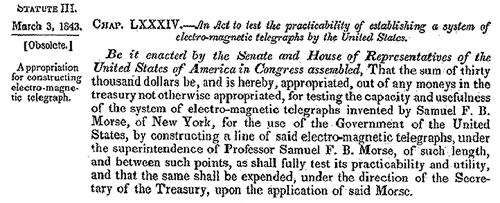The following are a some technological and conceptual Internet milestones. One really cannot say which was the "beginning" of the Internet.
|
Telegrams were transmitted on paper tape. Messages came to centers where operators separated them by tearing the tape. They fed the tape into a reader for the destination city or country. The operators did manually what routers do today. These were called torn tape systems.
|
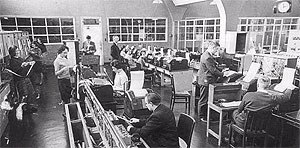
|
|
In 1940 George Stibitz demonstrated the Bell Labs Model I in New York using a terminal at Dartmouth College in New Hampshire.
Special purpose networks like SAGE (shown here), a network for spotting and tracking Soviet bombers, and SABRE, American Airlines' ticket reservation network were built during the 1950s and early 1960s. These networks were dedicated to a single application.
Proprietary networks in which all the computers and communication software and hardware were supplied by one vendor were available in the 1970s. IBM's System Network Architecture and Digital Equipment Corporation's DECNet were leaders during this time.
|

|
|
In 1964, Paul Baran wrote a series of reports proposing a large scale packet switching network in which computers did the message routing. The network was never built, but the report was influential.
This diagram shows Baran's conceptualization of three types of network: centralized, decentralized and distributed. He proposed a distributed (mesh) network because it would continue functioning even if one or more nodes were down.
In 1965, Donald Davies of the National Physical Laboratory in England also proposed a packet-switched computer network.
|
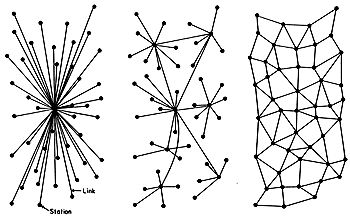 |
|
The ARPAnet was launched in 1969 with nodes at UCLA, the Stanford Research Institute, The University of Utah and the University of California at Santa Barbara.
Note that the network had dissimilar computers: an IBM 360, a Digital Equipment Corporation PDP-10, and two computers from Scientific Data Systems, a Sigma 7 and a 940. Today we freely mix computers from different manufacturers and running different operating systems on our networks, but that was not done on the proprietary networks that preceded the ARPAnet.
ARPAnet applications like file transfer and email accessed network services using The Network Control Program (NCP).
|
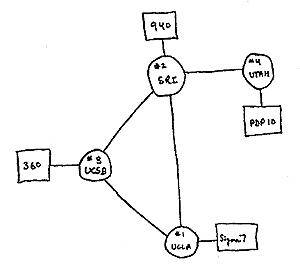
|
|
The ARPAnet was a single network, but others followed, and there was a desire to connect these dissimilar networks, to create an internetwork.
In 1974, Vint Cerf and Bob Kahn published a paper defining a Transmission Control Protocol for connecting dissimilar networks. Today we would call the gateways "routers," and the initial protocol was split into two layer, the Internet Protocol and the Transmission Control Protocol.
On January 1 1983, TCP/IP replaced NCP on the ARPAnet, creating the ARPA Internet, an internetwork, and marking marking the start of the Internet as we know it today.
|

|
|
In 1988 The U. S. National Science Foundation (NSF) established the NSFnet, a 13-node backbone connecting regional networks through large research computer centers. The initial links were only 50 kbps, around the speed of a dial-up modem today, but the speed was soon increased to 1.4 Mbps.
In addition to building the network, NSF assisted universities and research institutes in the U. S. A university with a local area network, could connect to one of the backbone nodes without charge. The NSF also paid for their router and communication line to the backbone node. They also encouraged foreign research networks without charge, and often helped them with equipment and communication costs.
|
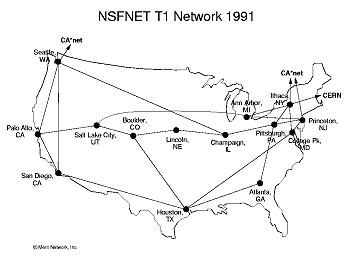
|
|
Vannevar Bush wrote an article speculating about a machine he called a "Memex" which researchers would use to store and work on their data and articles and communicate with other researchers.
Bush did not get the technology right -- he speculated that a Memex might use microfilm for storage -- but his vision inspired many researchers. Bush did not build the World Wide Web, but he imagined it.
|
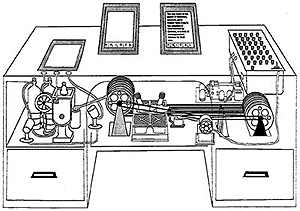
|
|
In 1962 J.C.R. Licklider & Wesley Clark, published On-Line Man Computer Communication speculating on a global network and the ways people would use it. Licklider also pioneered the conceptualization of a personal computer in which a user and the machine worked together.
As director of the ARPA Information Processing Techniques Office, Licklider was influential in funding much of the important research and development in both personal computing and networking.
|
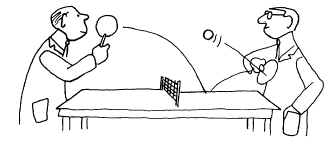
Interactive communication consists of short spurts of dialog ...
|
|
In 1962 Doug Engelbart, inspired by Bush, published a report on Augmenting Human Intellect with computers and communication. That paper and a subsequent paper and live demonstration (shown here) at a 1968 conference influenced and inspired many personal computer and network researchers.
Engelbart and his colleagues invented many things we take for granted today like word processing software that displays a document as it will appear when printed, computer conferencing, the mouse, and a host of tools to enable collaboration between members of team.
|
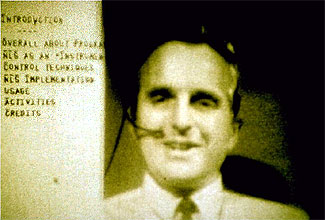
|
